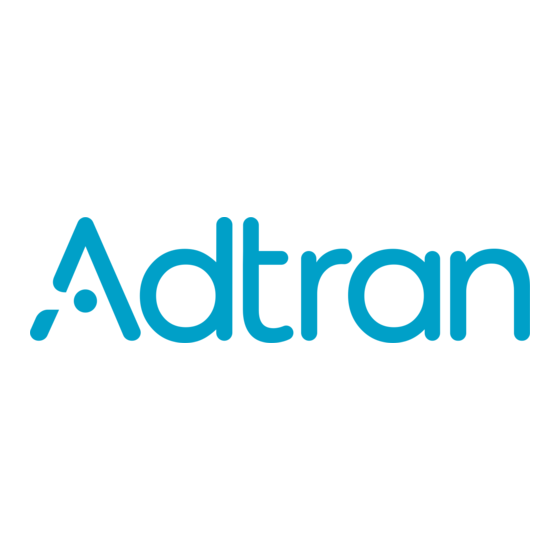

ADTRAN NetVanta 3000 Series Quick Configuration Manual
With t1/ft1 or t1/ft1 with dsx-1 network interface module
Hide thumbs
Also See for NetVanta 3000 Series:
- User manual (146 pages) ,
- Hardware installation manual (84 pages) ,
- Application manual (4 pages)
Table of Contents
Advertisement
Quick Links
NetVanta 3000
(with T1/FT1 or T1/FT1 with DSX-1 Network Interface Module)
Quick Configuration Guide
Equipment Required
•
Category 5 - UTP cable for connecting the system to the existing network.
•
VT100 terminal or PC with VT100 emulation software.
•
DB-9 (male) to DB-9 (female) straight-through serial cable for configuring the unit.
This quick configuration guide provides step-by-step instructions for configuring
your application. The configuration scripts are available on the ADTRAN OS
Documentation CD.
The configuration parameters used in the example outlined in this document are for
instructional purposes only. Please replace all underlined entries (example) with your
specific parameters to configure your application.
Network Diagrams
Frame Relay Diagram
Branch Office
eth 0/1
LAN IP: 10.10.20.7/24
PPP over Fractional T1 Connection Diagram
Branch Office
PBX
VPN
VPN
PWR
PWR
STAT
STAT
TD
TD
RD
RD
NetVanta 3200
eth 0/1
LAN IP:
10.10.20.7/24
Series
61200862L1-42A
NetVanta 3200
FT1 1-10 (64 kbps)
NetVanta 3200
VPN
VPN
WAN
WAN
LAN
LAN
PWR
PWR
STAT
STAT
TD
RD
RD
TD
TD
RD
RD
TD
TD
RD
FR 1
DLCI 16
Annex D Signaling
192.168.72.1/30
t1 1/2
t1 1/1
Point-to-Point T1
NetVanta 3200
WAN
WAN
LAN
LAN
TD
TD
RD
TD
RD
RD
DS0s 1-10 Data, 21-24 Voice
PPP 1
PPP Signaling
RIP V2
192.168.72.1/30
Technical Support 1-888-4ADTRAN (1-888-423-8726)
Corporate HQ
LAN IP: 10.10.10.1/24
Router
Gateway Router
192.168.72.2/30
Corporate HQ
LAN IP: 10.10.10.1/24
Router
Gateway Router
LAN IP: 192.168.72.2/30
November 2004
Advertisement
Table of Contents

Summary of Contents for ADTRAN NetVanta 3000 Series
- Page 1 DB-9 (male) to DB-9 (female) straight-through serial cable for configuring the unit. This quick configuration guide provides step-by-step instructions for configuring your application. The configuration scripts are available on the ADTRAN OS Documentation CD. The configuration parameters used in the example outlined in this document are for instructional purposes only.
- Page 2 Configure the Router The NetVanta may be initially accessed and managed via the DB-9 CONSOLE port located on the rear panel of the unit. The default Ethernet port parameters allow the NetVanta to be accessed using a hub and two Ethernet cables (one for the PC and one for the router). The default Ethernet IP address is 10.10.10.1.
- Page 3 Configure the Ethernet Port Parameters 1. Enter config terminal to enter the Global Configuration mode. 2. At the (config)# prompt, enter interface eth 0/1 to access the configuration parameters for the Ethernet port located on the rear panel of the unit. 3.
- Page 4 Create the PVC and Assign an IP Address 1. At the (config)# prompt, enter interface fr 1.16 to create a PVC assigned to Frame Relay virtual interface 1. This activates the configuration parameters for the PVC. Your prompt should now display (config-fr 1.16)#. 2.
- Page 5 2. Enter no shutdown to activate the T1 interface. 3. Enter exit to return to the Global Configuration mode. The NetVanta 3000 Series Routers automatically map DS0s 1 through 24 from the network connection of a T1/FT1 + DSX-1 NIM to the DSX-1 port. Creating a TDM group removes the specified DS0s from the DSX-1 map.
- Page 6 Complete the Installation The NetVanta is now configured and operational. Complete the installation by connecting the appropriate cables to the T1 and Ethernet networks. Please refer to the NetVanta 3000 Series Routers Hardware Installation Guide for more details on pinouts and cabling.







Need help?
Do you have a question about the NetVanta 3000 Series and is the answer not in the manual?
Questions and answers